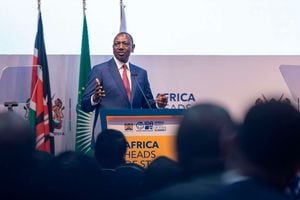OUT&ABOUT: Sojourn at a historic prison

The Shujaa Cells at Kapenguria Museum. PHOTO | RUPI MANGAT
What you need to know:
- Kapenguria is the historic town, where in the 1950s, the colonial government detained the six most influential leaders in the struggle for independence.
- The remote town did not have roads back then. It also lacked amenities such as electricity and water.
- Kapenguria became the scene of the infamous trial of the Kapenguria Six.
We’re at Barnley’s farm near Saiwa Swamp, which is famous for its rare herd of sitatunga antelope, when we learn that the road from Kitale to Kapenguria and beyond is now as smooth as silk. At first we think we are headed to a destination we had not planned on because until recently, the un-tarmacked road was treacherous despite the short distance.
Kapenguria is the historic town, where in the 1950s, the colonial government detained the six most influential leaders in the struggle for independence. The remote town did not have roads back then. It also lacked amenities such as electricity and water.
Kapenguria became the scene of the infamous trial of the Kapenguria Six — Bildad Kaggia, Kung'u Karumba, Jomo Kenyatta, Fred Kubai, Paul Ngei, and Achieng' Oneko. The six-month trial took place between December 1952 and April 1953. The charge against the six was that they were members of Mau Mau, which conspired to get rid of the white residents in Kenya.
The defendants were convicted, and sentenced to seven years’ imprisonment in Lokitaung near the desert shores of Lake Turkana, where no one could reach the convicts. On the smooth-as-silk tarmac road, it takes us 30 minutes from Saiwa Swamp to the prison-turned-museum at Kapenguria. When I last visited Kapenguria two decades ago, it looked more of a village. But not anymore. It now boasts modern hotels and tarmac roads that are more in sync with contemporary times. Kapenguria is also the capital of West Pokot County.
SHUJAA CELLS
I can only imagine the horror of the six men when they were escorted into the cells. Measuring five by 10 feet, each cell in the row has a tiny barred window so high up that it is unreachable and too small to allow an adult through. And in these tiny, dark cells, the men must have mused on their fate on moonless nights.
The tiny cells, now cleaned up, had simply nothing in them — no wash basin or toilet but only a corner to lie in. Each cell marks the occupant — a Shujaa (hero) — with their stories posted on the wall.
Outside the cells, it’s a bright afternoon and we walk through the exhibits of the local people — the Pokot and the Sengwer — with a peep at snakes in cages — the leaf-patterned Gaboon viper and the rare Rhinocerous viper supporting horns. Both snakes are found in the area as well as in Kakamega Forest, which is110 kilometres south.
Back to the infamous trial. The courtroom was too small and so a local school was used for the trial. The proceedings of the trial are at the museum, including the faded black and white pictures of two other nationalists — Pio Gama Pinto, the Kenyan journalist, politician and freedom fighter who became the independent Kenya's first martyr in 1965, and Makhan Singh. The fiery Sikh is credited for coining the term ‘Uhuru Sasa’, forming the first labour union in Kenya in 1935 and becoming the country’s longest serving political prisoner. He e spent 11 years in detention in the late 1950s in Lokitaung near Lake Turkana. In the museum, locals have nothing to tell the visitors about the two men.
With time on our hands, we take a scenic drive along the ridge of the Cherangany Hills, one of Kenya's most important water towers. The new tarmac road winds its way higher along a forest that has been cleared. It’s a scenic drive, with soil so pink that it looks unreal. The homesteads of the local people — the highland Pokot and the smaller Sengwer — dot the heights. Under clear sunny skies, the horizons touch the watery surface of the Turkwel Dam near Nasalot National Reserve. The dam on Turkwel River is fed by the waters of River Nzoia that originates from the Cherangany Hills and Mount Elgon faintly visible in the west. The Turkwel River then flows into the world’s largest permanent lake in a desert — Turkana.
www.rupitheafricantrotter.wordpress.com




